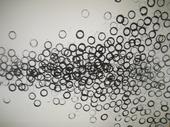After all the heavy philosophy present in my “Knowledge and Imagination” series, I figure we could all use some lighter stuff. So, I thought this might be a good time to respond to the people who ask me about my art project. Specifically, what it means, how to read it, and if they “get” it or not.
Okay, so first, let me give my disclaimer. I believe every tool we’ve ever developed can be useful. However, I am also sensitive to our tendency to overuse tools, causing us to forget that others may be available and more fitting for the current moment and need. For example, as a college instructor, I’ve come to believe that we over-learn the lessons of grade school; namely, conformity and learning to “pay attention” to the teacher. We often learn those tools so well, that we forget to think and feel and formulate from within. And then we might not even recognize that we might want to bring those formulations out for ourselves and others to hear expressed.
This art project is composed of writings that are, in their nature, ambiguous and ambivalent. I want the forces within them to tug at you and pull in different directions, to break apart your habitual perceptions and understandings in order to see what else might come out. It’s true that these writings come from this mix of a person called “kjirsten” –but my personal stories within them are peripheral. Even sacrificial. The best recommendations I can make to those who wonder how to view these pieces are as follows.
First, understand there is nothing to “get”. There is no single message in them. They are inert until you enter the scene. Your “you-ness” activates them. Whatever you feel, you find, you think is their message to you about you. They act as mirrors. Funny mirrors. What we find in them, what we experience from them is information about ourselves. They are not saying anything at all without you.
Second, trust yourself without rushing to “know”. These pieces are challenging for many of us because we may be accustomed to those lessons we’ve received since grade school:
Don’t raise your hand unless you know the right answer!
If you feel confused, you do not know the right answer!
There is no other answer except the right answer!
This art project is meant to assist us in exercising abilities that are neglected and devalued within our current cultural atmosphere. What do you feel? What brought on those feelings? Can you relax not “knowing”? Once we relax without knowing the “right” answer, our “selves” are free to roam into the art pieces, pick up what we may and create an incredibly unique, personal experience with that piece.
These pieces come from a manuscript that I call an unnarrated memoir. It is my unnarrated memoir, but when you entertain the pieces from that manuscript, interact with them, have experiences with them, they become your unnarrated memoir. They are mirrors that reflect a story of you. And if you re-read them at a later time, you might, like me, find that your memoir changes as the stream of life continues to flow through you. Often, new readings of them will bring insights pertinent to the current moment of my becoming me. May they do the same for you!
